Thank you for taking the time to express yourself without being condicending or illiciting a frankless attitude. I have learned from your postings.
I have not heard of the Speared Bison Jefferson modern nickel, what is it? I do enjoy the creative names on some of these
varieties, and I believe they help people remember them, and probably generate more interest.
From my recall-ection it is a stab wound/knife and/or "spear" so-to-speak- to the back of the bison (not bear) angling into the animal's hide. 1991? Some year in the modern era.
Below is analysis of the physical characteristics of the 1914 die #2 and a close up photo below
Extra metal to the left of the top of the 4
In front of the top of the 4
No clear top or bottom edge is seen.
No front vertical edge is seen, only die scratches.
No raised center of crossbar.
No actual end can be determined, so cannot determine a length
No corners seen of crossbar.
Extra metal to the right side of the 4.
The top right of the metal extends outward, then angles downward
to the right at about a 210 degrees, curves slightly at the right, then
angles downward at about 280 degrees, then angles inwards at about
280 degrees, then angles inwards at about 40 degrees.
The right top side is not squared.
The edge of the extra metal on the right side of the 4 is broken, not straight.
The metal on the right side of the 4 extends down below the height of a 3.
Summation - The size, shape, angles, edges of an actual 3 do not match that of the extra metal on the 1914/3 Die #2
1914 Die #2 - Most of the left side of the top of the 4 is covered by diagonal die scratches that extend from the diagonal bar of the 4 to two-thirds the distance to the 1. There are many horizontal and slightly angled die scratches above the top of the 4 extending from the back of the ribbon to above the 1. There does appear to be raised metal extending form the top left of the 4, but this could be the result of a horizontal die scratch. From the right side of the top of the 1 is horizontal die scratches that end one-third the distance between the 1 and 4. There is no left vertical edge or lower edge of an outline of a crossbar. There is no raised center that would indicate a crossbar. If a crossbar existed on the working die, it would be incused. If the Engraver abraded the incused crossbar, then they would created incused die scratches below the incused height of the crossbar, leaving a raised shelf of the crossbar on the coin, with die scratches above. There is no raised shelf of a crossbar.
On the right side of the top of the 4, the primary problem is that there is no defined edge or outline. The metal appears in layers. For example, on the lower side, the bottom or formed by a series of dots, above that, the metal is more raised, but without a definitive edge. The right side is jagged and broken in shape. Although from a general perspective, this extra metal might have the general appearance of the top right of a 3, a closer inspection shows that the outline does not match that of the top of a 3. The bottom of the right side extends down lower than a three would.
If the top of the 3 was partially hubbed into the working die, they there should be clear remnants of the crossbar and
top right corner of the 3. There are no die scratches to the right of the 3, therefore there was no attempt to remove
or distort, therefore if this was a 3, it should be in the shape and size of a 3. Why would the engraver, if he was attempting
to remove the remnants of a 3 polish way above the top of the 4, or above the 1, were they just sloppy?
Well I guess if the objective here was to whip this conversation up into a frothing roiling broiling lather we have all contributed to its success.
tom
Collector of Buffalo Nickels and other 20th century United States Coinage a.k.a "The BUFFINATOR"
Kevin’s next project will be working to prove that Santa, the Easter bunny, and the Tooth Fairy do not exist.
It will be included in his new upcoming book on "prOOf buFFalo nickels" as a 50 page appendix!
Collector of Buffalo Nickels and other 20th century United States Coinage a.k.a "The BUFFINATOR"
From my recall-ection it is a stab wound/knife and/or "spear" so-to-speak- to the back of the bison (not bear) angling into the animal's hide. 1991? Some year in the modern era.
That sounds pretty cool, especially during an era when we start see much fewer die varieties such as doubled dies, RPMs, and such.
Retired Collector & Dealer in Major Mint Error Coins & Currency since the 1960's.Co-Author of Whitman's "100 Greatest U.S. Mint Error Coins", and the Error Coin Encyclopedia, Vols., III & IV. Retired Authenticator for Major Mint Errors for PCGS. A 50+ Year PNG Member.A full-time numismatist since 1972, retired in 2022.
Look at most of the major peace dollar die varieties, die gouges, cracks, and so on, most have names, as to what they appear like. A modern die gouge variety is something people can find in pocket change.
Remember Frank Spadone's book on die varieties. If it generates interest in collecting and studying coins for someone, its
all good.
@koynekwest said:
Kevin-you can no more PROVE that this is ISN'T an overdate that I can PROVE that it IS. Several well respected specialists do believe that it is, indeed, a legitimate overdate. All opinions, one way or the other should be respected. As far as PCGS goes, If I'm not mistaken they still attribute it by FS# and with a 4/3 in parentheses. If I'm mistaken about this I would appreciate it if someone will correct me.
Ron,
That is my point, from your own words, you cannot prove it is an overdate. Yet you and Tom claim it is an overdate.
I can prove through the physical characteristics and diagnostics that the size, shape, angles, edges, height, and everything
else cannot be the remnants of a 3.
There are no die polishing on the back of the 4 on any of these varieties, yet, the size, shape, edges, .... on the extra metal
is all different. If it was a 3 initially hubbed into the die, it should be consistent in size, shape, and everything else, it could
not for example, have a diagonal that has a much higher degree, and extend down to almost the cross bar of the 4.
On PCGS, they were using 1914/3
Now they will reference the FS number for the two primary varieties. This is stating that it is the same variety as listed in
CP. ANACS has done the same, if they believe it is an overdate/OMM ...., they will list it as such, otherwise, they will also
list it by reference.
They move the 3 to a (3), to list it as a questionable variety, which IMO is a great middle ground, so that a collector
interested in it will know it is one of the varieties, but also understand that PCGS is not asserting that they believe
it is an overdate.
IMO, it does not matter what I personally say or any other person says, IMO, the most important criteria is the coins
themselves, and the evidence they present. That is what collectors should base their conclusions on, not on who
presents it. Which is why I would prefer to not talk opinions, but hard facts and evidence from the coins with you.
Kevin
Kevin,
I am stating an opinion.
You are making a claim.
Tom
Numismatist. 54 year member ANA. Former ANA Senior Authenticator. Winner of four ANA Heath Literary Awards; three Wayte and Olga Raymond Literary Awards; Numismatist of the Year Award 2009, and Lifetime Achievement Award 2020. Author "The Enigmatic Lincoln Cents of 1922," due out late 2025.
@TwoSides2aCoin said:
Oh let's not bring in the speared bison. The poor gal who found it was run out of town.
curious, why was she run out of town??
Hi Kevin. I'm Joe.
About that lady... as I recall , it was she who discovered a huge die crack error in a roll of the 2005 D Bison Nickels, shared it here, got some graded, and out to collectors via the market they went. Then I think something harsh may have been written on the boards long ago by someone during those days, and she left the forum. Haven't seen hide nor tail , since. The coin ? I'm not sure what they're trading for, but I am more interested in TD's Cheerios dollar, as variety goes.
Now back to our regularly scheduled program. " what's it worth ? "
Hi Joe,
Yeah, sometimes you have to have a thick hide on here, no place normally for the weak of heart.
Whats it worth, great topic, normally the answer is whatever someone is willing to pay.
But part of why I had interest in the speared bison is how I have seen names applied to many a die variety
with association built, memory, and interest and collectability rise.
Sometimes it drives me nuts as I normally take a scientific approach, collecting all data on similar varieties
pricing, and such, but found cool names increased value. I might disagree with it, but cannot ignore the reality
of it.
I also find interesting the prices paid for the highest grade for each date and mint mark by those who want a
few extra points for their registry sets. Old series and coins, fine, but modern series, sometimes it ridiculous,
but perhaps not to those competing, or have endless resources.
On a different note, coins connected to a story, such as the 1969-S Doubled die will have much higher interest.
Compare the 1943 copper cents vs the 1974-D silver Ikes.
Lots of diverse topics on this subject.
Kevin
Kevin,
I am stating an opinion.
You are making a claim.
Tom
Tom,
Was not speaking of you, but Buffnixx, who is also Tom
Kevin
Got it.
TD
Numismatist. 54 year member ANA. Former ANA Senior Authenticator. Winner of four ANA Heath Literary Awards; three Wayte and Olga Raymond Literary Awards; Numismatist of the Year Award 2009, and Lifetime Achievement Award 2020. Author "The Enigmatic Lincoln Cents of 1922," due out late 2025.
Extra metal to the left of the top of the 4
In front of the top of the 4
No clear top or bottom edge is seen.
No front vertical edge is seen, only die scratches.
No raised center of crossbar.
No actual end can be determined, so cannot determine a length
No corners seen of crossbar.
Extra metal to the right side of the 4.
The top right of the metal extends outward, then angles downward
to the right at about a 210 degrees, curves slightly at the right, then
angles downward at about 280 degrees, then angles inwards at about
280 degrees, then angles inwards at about 40 degrees.
The right top side is not squared.
The edge of the extra metal on the right side of the 4 is broken, not straight.
The metal on the right side of the 4 extends down below the height of a 3.
IS ANYONE CONFUSED YET, IF SO I THINK WE NEED MORE INFORMATION
Numismatist. 54 year member ANA. Former ANA Senior Authenticator. Winner of four ANA Heath Literary Awards; three Wayte and Olga Raymond Literary Awards; Numismatist of the Year Award 2009, and Lifetime Achievement Award 2020. Author "The Enigmatic Lincoln Cents of 1922," due out late 2025.
above photo of the overdate 1914/3 courtesy of koyneqwest. From his book on abraded die buffalo nickels.
They say a picture is worth a thousand words and I think the above pic is worth 10,000 words!
Collector of Buffalo Nickels and other 20th century United States Coinage a.k.a "The BUFFINATOR"
(BELOW -- 1914 OVER 1913 PROVES THAT THE 1914 MH WAS MADE FROM A 3 DIGIT PARTIAL 1913 MH; NOTE HOW THE 191 ALIGN PERFECTLY)
====================================================================================================
(BELOW -- 1913 OVER 1914; SHOWS HOW THE TOP BAR OF THE 3 EXTENDS JUST RIGHT OF THE VERTICAL BAR OF THE 4
====================================================================================================
(BELOW - 1913 OVER 1914/3 SHOW THAT THE TOP BAR OF 3 FALLS INTO THE PATH OF THE DIE SCRATCHES IN FRONT OF
AND BEHIND THE 4 THOUGH MANY DIE SCRATCHES ARE ABOVE THE 4
Collector of Buffalo Nickels and other 20th century United States Coinage a.k.a "The BUFFINATOR"
ABOVE PHOTOS FROM DR. JAMES WILES’ STUDY OF THE 1914/3 OVERDATED BUFFALO NICKELS
SEE CONECA WEBSITE (WWW DOT VARIETYVISTA DOT COM) FOR MORE INFORMATION.
Collector of Buffalo Nickels and other 20th century United States Coinage a.k.a "The BUFFINATOR"
Thanks, you actually proved my point exactly.
This is why we were all fooled when this variety was discovered in 1996.
If you take a high level view, then you might think it has the general look of an underlying 3.
Its when you take a look at the details of the diagnostics and physical characteristics, that you
understand that it cannot be the remnants of an underlying 3.
The low grade variety presented by Tom above is Die #1. Below is a close up of an EDS uncirculated specimen of Die #1
and the analysis.
Metal to the left of the top of the 4 - On Die #1, On the left side of the top of the 4, there is only a single die scratch. Right below the top of the left side of the 4, a single die scratch extends outward to the left to about two-thirds the distance to the 1. The line is very jagged and two small extensions are seen from the bottom. There is no defined shape of a crossbar, no upper, lower, or end edge of a crossbar of a 3. There is no corners of the crossbar. There is no raised middle of a crossbar. There are several raised die scratches above the 4 that extend from the back of the ribbon to over the top of the 1. If a 3 was hubbed into the working die, then there should be an incused outline and center of the crossbar of the 3. There should be a raised plateau on the coin for these varieties. None exists. The die scratches above the date on several of these varieties that extend from the ribbon to above the 1 also imply/evidence towards that the Engraver was attempting to remove something else.
Top right side of the 4 – The top right side of the 3 on the 1913 working die is the closest part of the date to the center of the
working die. Therefore, it would be hubbed before the other digits, and most likely receive the strongest part of a strike during a partial hubbing of only part of the date was hubbed. As no part of the top right corner of the 3 is overlaid by the 4, it should have a clear outline. See the top right corner of the 7 on the 1918/7-D, which has a clearly defined outline and a bold full strike. None of the alleged 1914/3 varieties have die scratches to the right of the top of the 4,so this area was not abraded, which might distort the outline slightly. In analyzing the top right corner on these varieties, on Die #1, a raised line extends from right below the top right side of the 4. It curves almost directly downward in a semicircle shaped with broken edges. On the top right side of the broken semicircle, there appears there is a broken piece, which extends down, the back to the right with a jagged edge. Then the line extends back inward to the 4. A line extends from the top down through the middle of the semicircle. The bottom edge of the metal appears very thin compared to upper part of the metal The size, shape, angles, edges, contours, and height of the metal show that the extra metal to the top right of the 4 is not the remnants of a 3.
I wonder why the engraving department went to so much trouble to tool out the area about the 4 on so many dies?
Numismatist. 54 year member ANA. Former ANA Senior Authenticator. Winner of four ANA Heath Literary Awards; three Wayte and Olga Raymond Literary Awards; Numismatist of the Year Award 2009, and Lifetime Achievement Award 2020. Author "The Enigmatic Lincoln Cents of 1922," due out late 2025.
Here is another one I got off of the flea (eBay)
It turned out to be a 1914/3, bought for $8.50 and sold for about $50.
From my perspective there is still substantial collector interest in this variety, people are adding it to their sets.
Not so much for the 1914/3-s and 1914/3-d though as these are not that generally known.
Collector of Buffalo Nickels and other 20th century United States Coinage a.k.a "The BUFFINATOR"
HERE IS WHAT PCGS COIN FACTS SAYS ABOUT THE 1914/(3) BUFFALO NICKEL, AND THEY DO PUT PARANTHESES AROUND THE 3
-------------------------------------------------------------------------------------------------------------------------------------------------------------------------------Ron Guth: Experts speculate that the 1914/3 Nickel was caused when a 1913 dated master die was repunched with a 1914 dated hub. This theory is supported by the fact that there are several different overdate dies, plus overdates reported for both the 1914-D and 1914-S Nickels. The strongest 1914/3 die from the Philadelphia mint is known as FS-101 (old FS-014.87). The closeup illustrated above is from a different die and shows doubling on all digits of the date, plus a fairly strong top of the 3. Value for this variety depends on the strength (visibility of the doubling). Thus, the FS-101 commands the highest premium. Other, less visible overdates command smaller premiums. (WHAT SAY YOU KEVINJ?)
Collector of Buffalo Nickels and other 20th century United States Coinage a.k.a "The BUFFINATOR"
I wrote Ron to see if he remembers when he wrote that, and what he thinks now, will get back on that.
On die #1, the date is not doubled, it is strike doubling.
On the subject of whether it could be a master die that could be first hubbed by a 1913 dated working hub,
then a 1914 dated working hub.
This is all covered in my white paper on the subject and it is completely refuted, anyone who wants to read it, just
write me.
Kevin
kevinjflynn88@yahoo.com
The 1914/3-d was featured in a Coin World article in 2000 by Bill Fivaz entitled “Hitting for the cycle with the 1914/3-d buffalo nickel”. There is a die break running from the rim at about 9 o’clock in towards the center of the coin and under the topmost feather. The appearance of the crossbar is weak. But, it has been given an FS number of FS-014.88 while the S gets an FS number of FS-14.89. The S and D versions of this well trampled variety are weak and I really try to stay out of that area
though if you want to find one for the price of a regular non variety coin and stick it in your set norhing wrong with that.
Right now there are 5 examples on eBay (the flea) , 2 slabbed and 3 raw with prices ranging from $125 to $1099.
Collector of Buffalo Nickels and other 20th century United States Coinage a.k.a "The BUFFINATOR"
I wrote Ron to see if he remembers when he wrote that, and what he thinks now, will get back on that.
On die #1, the date is not doubled, it is strike doubling.
On the subject of whether it could be a master die that could be first hubbed by a 1913 dated working hub,
then a 1914 dated working hub.
This is all covered in my white paper on the subject and it is completely refuted, anyone who wants to read it, just
write me.
Kevin
kevinjflynn88@yahoo.com
Kevin
Sounds to me after reading the pcgs maintained Coin Facts there is still support for this variety at PCGS, though they have changed 1914/3 to
1914/(3) which is, as the late great Walter Breen used to say, is “weasel wording”.
Collector of Buffalo Nickels and other 20th century United States Coinage a.k.a "The BUFFINATOR"
Another little tidbit about the 1914/3-d:
It comes with two different reverse dies, usually referred to as “reverse die A” and “reverse die B”. Just two different mintmark positions, one close to the letters in the denomination and the other further away. So you might run into a SEGS slab with one of these two annotations on the insert indicating which reverse die it is.
Collector of Buffalo Nickels and other 20th century United States Coinage a.k.a "The BUFFINATOR"
@abcde12345 said:
Will zinc acid bring out the bottom of the three to the top of the four or is it the other aways around?
I think the most commonly used way to bring back details on a warn nickel is an acid called “inc-a-date” which has been
sold commercially for over 50 years. I think it is sulfuric acid. Does a good job but the coin must be carefully rinsed after application and detail restoration or else the coin will turn an ugly black.
Collector of Buffalo Nickels and other 20th century United States Coinage a.k.a "The BUFFINATOR"
@RockyMtnProspector said:
I had an ANACS rep tell me the 1914/3 was a no go, so check in advance.
Went to a coin show and in a dealer’s case was a nice fine-12 anacs 1914 buffalo nickel. I asked myself “Why would someone go tot he trouble of slabbing a fine 1914 nickel?” Then it hit me. I wound up buying a really sharp 1914/3 overdate buffalo nickel for chump change that the previous owner had given up on. One of the strongest 4/3’s I have ever seen it and anacs would not even give it a sniff. And to add insult to unjust they slabbed it as a regular 1914 nickel and kept the submitters money!
Collector of Buffalo Nickels and other 20th century United States Coinage a.k.a "The BUFFINATOR"
Here are the ANACS statistics for the 1914/3 overdate buffalo nickel
(date ) (variety attribution) (total slabbed)
1914/3 -- FS-101 -- 179
1914/3 -- late die state -- 13
1914/3 -- WDDO-003 PLATE -- 1
1914/3 -- (details grades) -- 113
totals -- 306
looks like one of the plate coins from one of Kevin Flynn and John Wexler’s books has gotten attributed along the way!
I don’t think you can say this shows a lot of disinterest from the buffalo nickel collectors.
in fact just the opposite.
(the term WDDO means Wexler DDO)
Collector of Buffalo Nickels and other 20th century United States Coinage a.k.a "The BUFFINATOR"
and for the San Francisco mint ANACS has slabbed the following
(date) -- (attribution) -- (total)
1914/3s -- FS-101 -- 6
1914/3s -- FS-101 -- 3 (details grades)
total -- -- 9
(none graded for 1914/3-d though)
so ANACS has graded a total of 315 p and s mint overdates that are now out there in dealer and
collector hands.
Collector of Buffalo Nickels and other 20th century United States Coinage a.k.a "The BUFFINATOR"
I just checked the registry sets and in the basic set with varieties the “1914/3 overdate FS-101” is included and most of the big hitters with these sets have one, some in mint state.
Collector of Buffalo Nickels and other 20th century United States Coinage a.k.a "The BUFFINATOR"
Comments
From my recall-ection it is a stab wound/knife and/or "spear" so-to-speak- to the back of the bison (not bear) angling into the animal's hide. 1991? Some year in the modern era.
Below is analysis of the physical characteristics of the 1914 die #2 and a close up photo below
Extra metal to the left of the top of the 4
In front of the top of the 4
No clear top or bottom edge is seen.
No front vertical edge is seen, only die scratches.
No raised center of crossbar.
No actual end can be determined, so cannot determine a length
No corners seen of crossbar.
Extra metal to the right side of the 4.
The top right of the metal extends outward, then angles downward
to the right at about a 210 degrees, curves slightly at the right, then
angles downward at about 280 degrees, then angles inwards at about
280 degrees, then angles inwards at about 40 degrees.
The right top side is not squared.
The edge of the extra metal on the right side of the 4 is broken, not straight.
The metal on the right side of the 4 extends down below the height of a 3.
Summation - The size, shape, angles, edges of an actual 3 do not match that of the extra metal on the 1914/3 Die #2
1914 Die #2 - Most of the left side of the top of the 4 is covered by diagonal die scratches that extend from the diagonal bar of the 4 to two-thirds the distance to the 1. There are many horizontal and slightly angled die scratches above the top of the 4 extending from the back of the ribbon to above the 1. There does appear to be raised metal extending form the top left of the 4, but this could be the result of a horizontal die scratch. From the right side of the top of the 1 is horizontal die scratches that end one-third the distance between the 1 and 4. There is no left vertical edge or lower edge of an outline of a crossbar. There is no raised center that would indicate a crossbar. If a crossbar existed on the working die, it would be incused. If the Engraver abraded the incused crossbar, then they would created incused die scratches below the incused height of the crossbar, leaving a raised shelf of the crossbar on the coin, with die scratches above. There is no raised shelf of a crossbar.
On the right side of the top of the 4, the primary problem is that there is no defined edge or outline. The metal appears in layers. For example, on the lower side, the bottom or formed by a series of dots, above that, the metal is more raised, but without a definitive edge. The right side is jagged and broken in shape. Although from a general perspective, this extra metal might have the general appearance of the top right of a 3, a closer inspection shows that the outline does not match that of the top of a 3. The bottom of the right side extends down lower than a three would.
If the top of the 3 was partially hubbed into the working die, they there should be clear remnants of the crossbar and
top right corner of the 3. There are no die scratches to the right of the 3, therefore there was no attempt to remove
or distort, therefore if this was a 3, it should be in the shape and size of a 3. Why would the engraver, if he was attempting
to remove the remnants of a 3 polish way above the top of the 4, or above the 1, were they just sloppy?
This is not an overdate
Kevin
Well I guess if the objective here was to whip this conversation up into a frothing roiling broiling lather we have all contributed to its success.
tom
a.k.a "The BUFFINATOR"
Kevin’s next project will be working to prove that Santa, the Easter bunny, and the Tooth Fairy do not exist.
It will be included in his new upcoming book on "prOOf buFFalo nickels" as a 50 page appendix!
a.k.a "The BUFFINATOR"
That sounds pretty cool, especially during an era when we start see much fewer die varieties such as doubled dies, RPMs, and such.
It's a die gouge that's been promoted.
On 2005's I think, but don't quote me on the date
Oh let's not bring in the speared bison. The poor gal who found it was run out of town.
``https://ebay.us/m/KxolR5
Look at most of the major peace dollar die varieties, die gouges, cracks, and so on, most have names, as to what they appear like. A modern die gouge variety is something people can find in pocket change.
Remember Frank Spadone's book on die varieties. If it generates interest in collecting and studying coins for someone, its
all good.
curious, why was she run out of town??
Fred,
You are one of the most respected numismatists I know, curious if you have seen any of the 1914/3 varieties
and what your thoughts are?
Thanks
Kevin
Kevin,
I am stating an opinion.
You are making a claim.
Tom
Tom,
Was not speaking of you, but Buffnixx, who is also Tom
Kevin
Hi Kevin. I'm Joe.
About that lady... as I recall , it was she who discovered a huge die crack error in a roll of the 2005 D Bison Nickels, shared it here, got some graded, and out to collectors via the market they went. Then I think something harsh may have been written on the boards long ago by someone during those days, and she left the forum. Haven't seen hide nor tail , since. The coin ? I'm not sure what they're trading for, but I am more interested in TD's Cheerios dollar, as variety goes.
Now back to our regularly scheduled program. " what's it worth ? "
``https://ebay.us/m/KxolR5
Hi Joe,
Yeah, sometimes you have to have a thick hide on here, no place normally for the weak of heart.
Whats it worth, great topic, normally the answer is whatever someone is willing to pay.
But part of why I had interest in the speared bison is how I have seen names applied to many a die variety
with association built, memory, and interest and collectability rise.
Sometimes it drives me nuts as I normally take a scientific approach, collecting all data on similar varieties
pricing, and such, but found cool names increased value. I might disagree with it, but cannot ignore the reality
of it.
I also find interesting the prices paid for the highest grade for each date and mint mark by those who want a
few extra points for their registry sets. Old series and coins, fine, but modern series, sometimes it ridiculous,
but perhaps not to those competing, or have endless resources.
On a different note, coins connected to a story, such as the 1969-S Doubled die will have much higher interest.
Compare the 1943 copper cents vs the 1974-D silver Ikes.
Lots of diverse topics on this subject.
Kevin
Got it.
TD
Extra metal to the left of the top of the 4
In front of the top of the 4
No clear top or bottom edge is seen.
No front vertical edge is seen, only die scratches.
No raised center of crossbar.
No actual end can be determined, so cannot determine a length
No corners seen of crossbar.
Extra metal to the right side of the 4.
The top right of the metal extends outward, then angles downward
to the right at about a 210 degrees, curves slightly at the right, then
angles downward at about 280 degrees, then angles inwards at about
280 degrees, then angles inwards at about 40 degrees.
The right top side is not squared.
The edge of the extra metal on the right side of the 4 is broken, not straight.
The metal on the right side of the 4 extends down below the height of a 3.
IS ANYONE CONFUSED YET, IF SO I THINK WE NEED MORE INFORMATION
a.k.a "The BUFFINATOR"
a.k.a "The BUFFINATOR"
Very nice!
above photo of the overdate 1914/3 courtesy of koyneqwest. From his book on abraded die buffalo nickels.
They say a picture is worth a thousand words and I think the above pic is worth 10,000 words!
a.k.a "The BUFFINATOR"
a.k.a "The BUFFINATOR"
above two photos courtesy of koynekwest.
a.k.a "The BUFFINATOR"
(BELOW -- 1914 OVER 1913 PROVES THAT THE 1914 MH WAS MADE FROM A 3 DIGIT PARTIAL 1913 MH; NOTE HOW THE 191 ALIGN PERFECTLY)
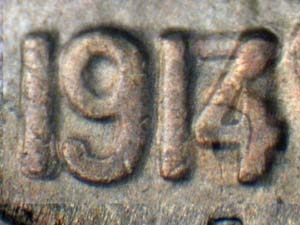
====================================================================================================
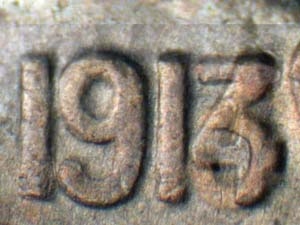
(BELOW -- 1913 OVER 1914; SHOWS HOW THE TOP BAR OF THE 3 EXTENDS JUST RIGHT OF THE VERTICAL BAR OF THE 4
====================================================================================================
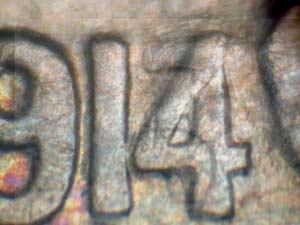
(BELOW - 1913 OVER 1914/3 SHOW THAT THE TOP BAR OF 3 FALLS INTO THE PATH OF THE DIE SCRATCHES IN FRONT OF
AND BEHIND THE 4 THOUGH MANY DIE SCRATCHES ARE ABOVE THE 4
a.k.a "The BUFFINATOR"
ABOVE PHOTOS FROM DR. JAMES WILES’ STUDY OF THE 1914/3 OVERDATED BUFFALO NICKELS
SEE CONECA WEBSITE (WWW DOT VARIETYVISTA DOT COM) FOR MORE INFORMATION.
a.k.a "The BUFFINATOR"
above three photos supplied by Koynekwest
a.k.a "The BUFFINATOR"
Tom, (buffnixx)
Thanks, you actually proved my point exactly.
This is why we were all fooled when this variety was discovered in 1996.
If you take a high level view, then you might think it has the general look of an underlying 3.
Its when you take a look at the details of the diagnostics and physical characteristics, that you
understand that it cannot be the remnants of an underlying 3.
The low grade variety presented by Tom above is Die #1. Below is a close up of an EDS uncirculated specimen of Die #1
and the analysis.
Metal to the left of the top of the 4 - On Die #1, On the left side of the top of the 4, there is only a single die scratch. Right below the top of the left side of the 4, a single die scratch extends outward to the left to about two-thirds the distance to the 1. The line is very jagged and two small extensions are seen from the bottom. There is no defined shape of a crossbar, no upper, lower, or end edge of a crossbar of a 3. There is no corners of the crossbar. There is no raised middle of a crossbar. There are several raised die scratches above the 4 that extend from the back of the ribbon to over the top of the 1. If a 3 was hubbed into the working die, then there should be an incused outline and center of the crossbar of the 3. There should be a raised plateau on the coin for these varieties. None exists. The die scratches above the date on several of these varieties that extend from the ribbon to above the 1 also imply/evidence towards that the Engraver was attempting to remove something else.
Top right side of the 4 – The top right side of the 3 on the 1913 working die is the closest part of the date to the center of the
working die. Therefore, it would be hubbed before the other digits, and most likely receive the strongest part of a strike during a partial hubbing of only part of the date was hubbed. As no part of the top right corner of the 3 is overlaid by the 4, it should have a clear outline. See the top right corner of the 7 on the 1918/7-D, which has a clearly defined outline and a bold full strike. None of the alleged 1914/3 varieties have die scratches to the right of the top of the 4,so this area was not abraded, which might distort the outline slightly. In analyzing the top right corner on these varieties, on Die #1, a raised line extends from right below the top right side of the 4. It curves almost directly downward in a semicircle shaped with broken edges. On the top right side of the broken semicircle, there appears there is a broken piece, which extends down, the back to the right with a jagged edge. Then the line extends back inward to the 4. A line extends from the top down through the middle of the semicircle. The bottom edge of the metal appears very thin compared to upper part of the metal The size, shape, angles, edges, contours, and height of the metal show that the extra metal to the top right of the 4 is not the remnants of a 3.
Kevin
I wonder why the engraving department went to so much trouble to tool out the area about the 4 on so many dies?
Agreed. That the biggest puzzle of this variety.
Here is a nice example of die number nine (referring to Konyeqwett’s book on abraded die buffs) which I got unattributed off of eBay.
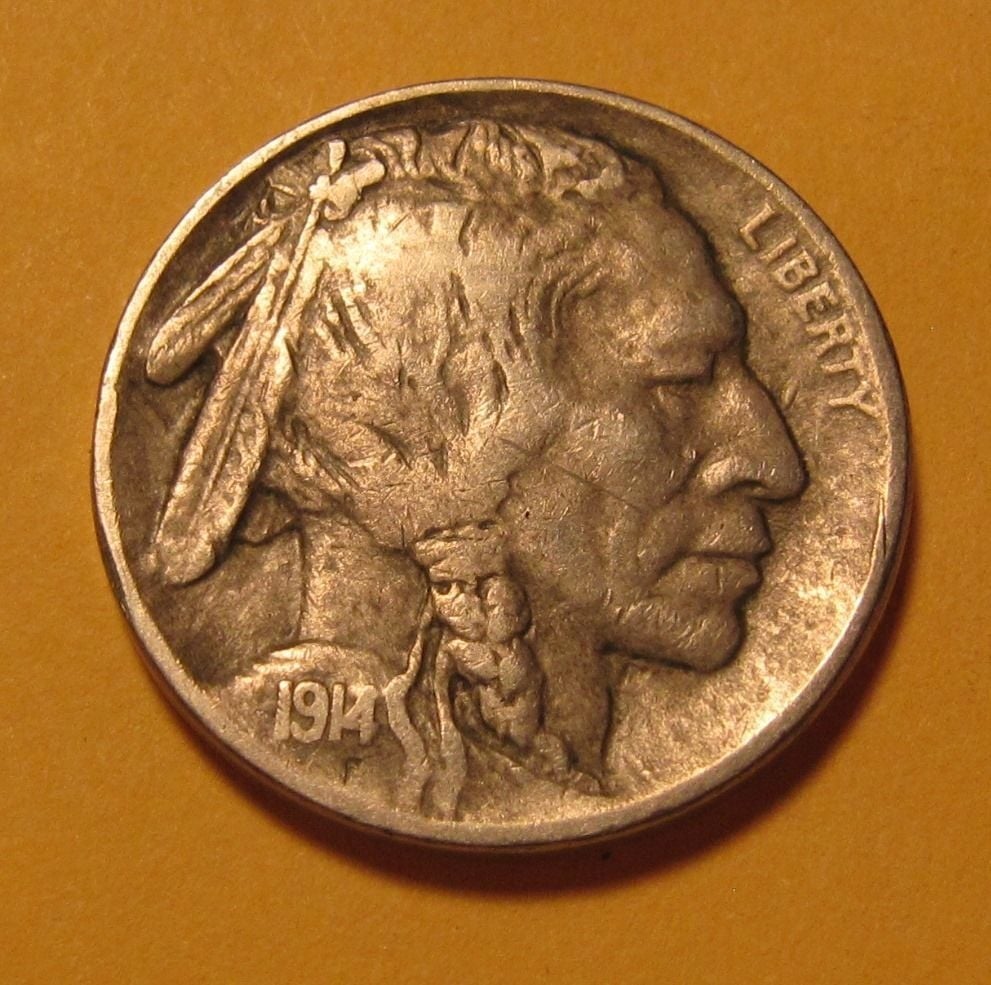
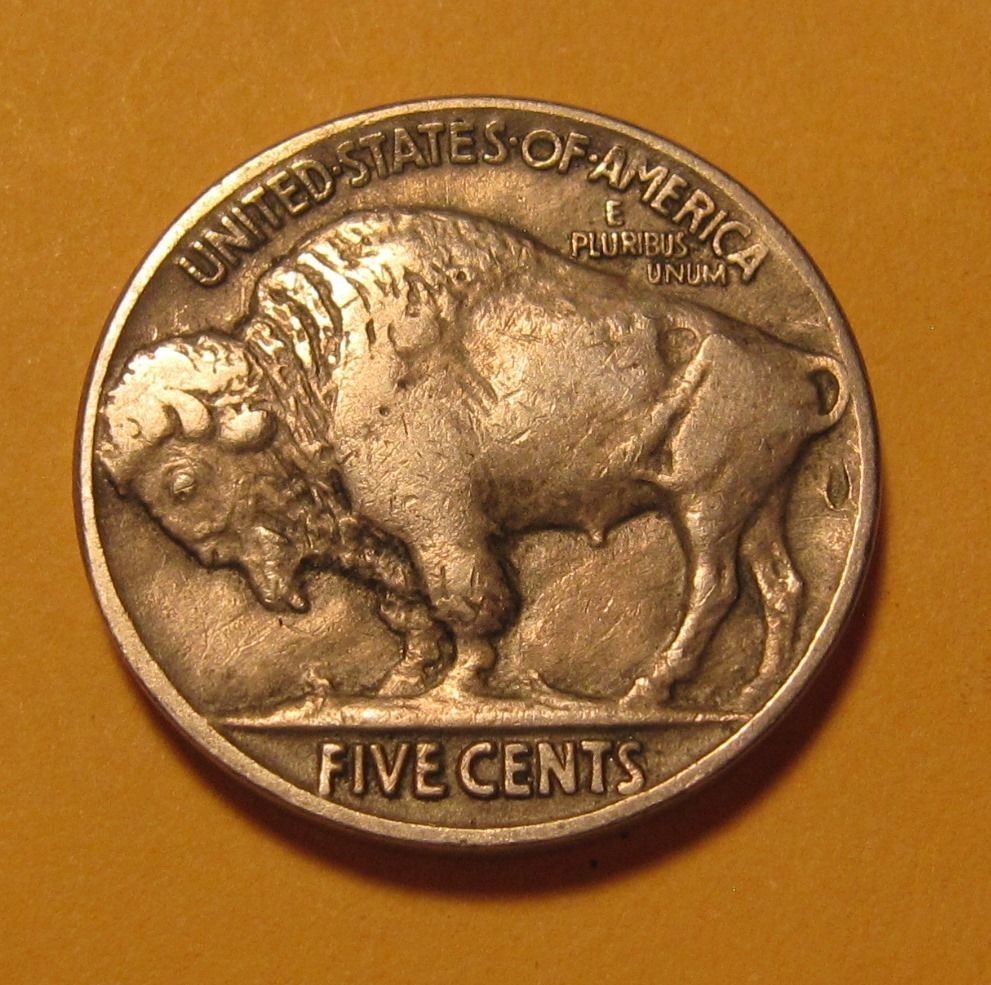
a.k.a "The BUFFINATOR"
and here is another one in the mail to me right now and looks promising for the remnants of the crossbar atop the 4.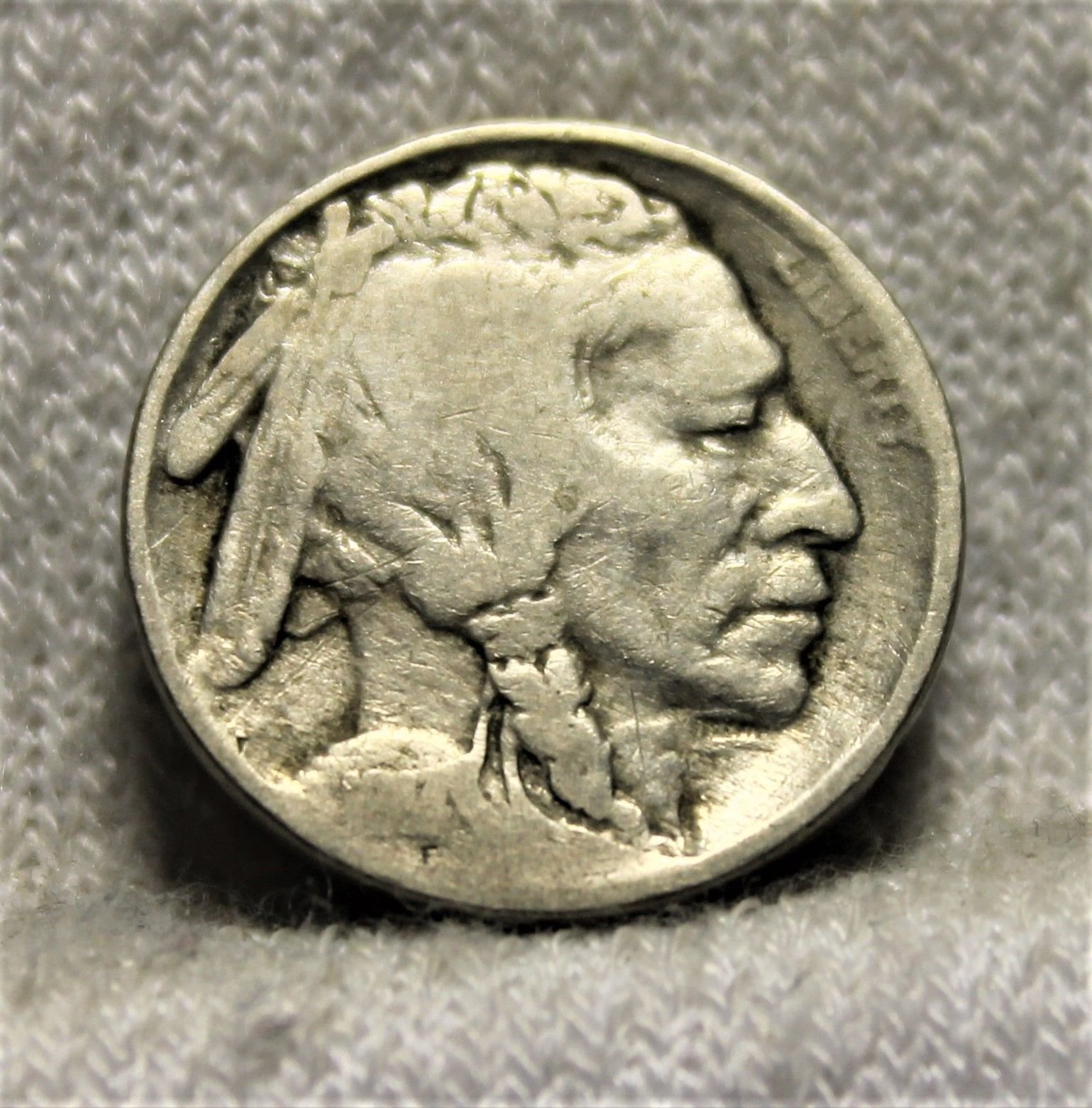
a.k.a "The BUFFINATOR"
Will zinc acid bring out the bottom of the three to the top of the four or is it the other aways around?
Here is another one I got off of the flea (eBay)
It turned out to be a 1914/3, bought for $8.50 and sold for about $50.
From my perspective there is still substantial collector interest in this variety, people are adding it to their sets.
Not so much for the 1914/3-s and 1914/3-d though as these are not that generally known.
a.k.a "The BUFFINATOR"
HERE IS WHAT PCGS COIN FACTS SAYS ABOUT THE 1914/(3) BUFFALO NICKEL, AND THEY DO PUT PARANTHESES AROUND THE 3
-------------------------------------------------------------------------------------------------------------------------------------------------------------------------------Ron Guth: Experts speculate that the 1914/3 Nickel was caused when a 1913 dated master die was repunched with a 1914 dated hub. This theory is supported by the fact that there are several different overdate dies, plus overdates reported for both the 1914-D and 1914-S Nickels. The strongest 1914/3 die from the Philadelphia mint is known as FS-101 (old FS-014.87). The closeup illustrated above is from a different die and shows doubling on all digits of the date, plus a fairly strong top of the 3. Value for this variety depends on the strength (visibility of the doubling). Thus, the FS-101 commands the highest premium. Other, less visible overdates command smaller premiums. (WHAT SAY YOU KEVINJ?)
a.k.a "The BUFFINATOR"
MIGHT JUST AS WELL ADD THIS.....
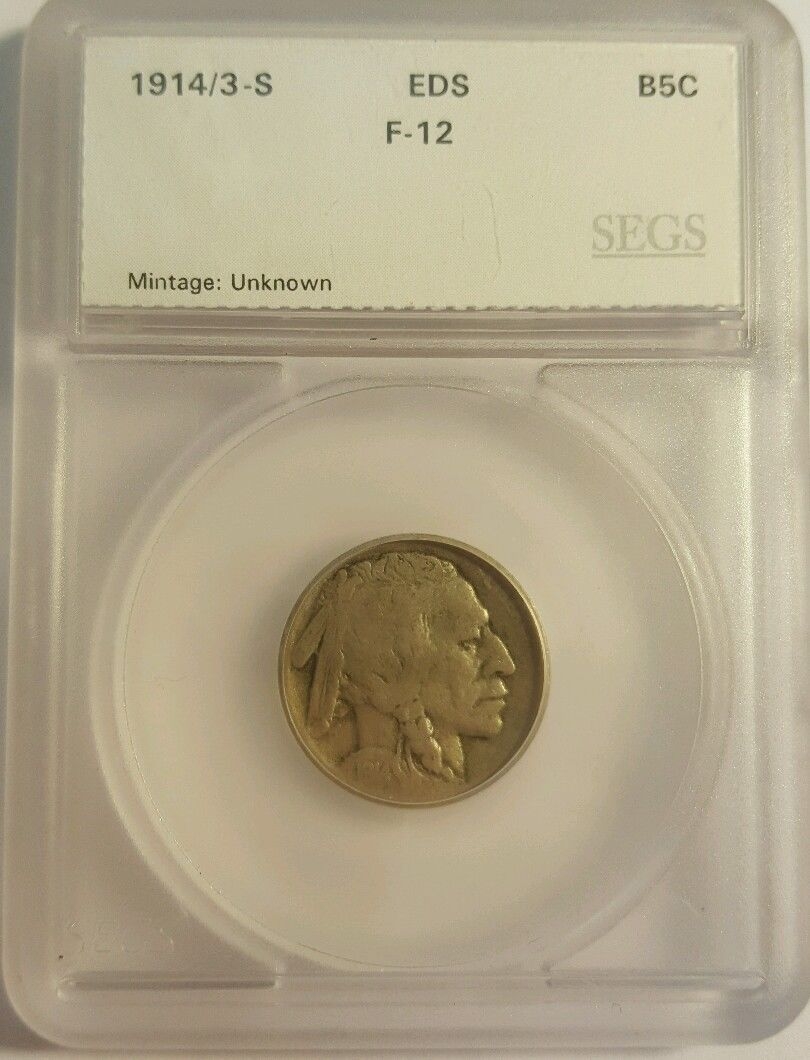
a.k.a "The BUFFINATOR"
AND THIS.......

a.k.a "The BUFFINATOR"
Tom (Buffnixx)
I wrote Ron to see if he remembers when he wrote that, and what he thinks now, will get back on that.
On die #1, the date is not doubled, it is strike doubling.
On the subject of whether it could be a master die that could be first hubbed by a 1913 dated working hub,
then a 1914 dated working hub.
This is all covered in my white paper on the subject and it is completely refuted, anyone who wants to read it, just
write me.
Kevin
kevinjflynn88@yahoo.com
The 1914/3-d was featured in a Coin World article in 2000 by Bill Fivaz entitled “Hitting for the cycle with the 1914/3-d buffalo nickel”. There is a die break running from the rim at about 9 o’clock in towards the center of the coin and under the topmost feather. The appearance of the crossbar is weak. But, it has been given an FS number of FS-014.88 while the S gets an FS number of FS-14.89. The S and D versions of this well trampled variety are weak and I really try to stay out of that area
though if you want to find one for the price of a regular non variety coin and stick it in your set norhing wrong with that.
Right now there are 5 examples on eBay (the flea) , 2 slabbed and 3 raw with prices ranging from $125 to $1099.
a.k.a "The BUFFINATOR"
Kevin
Sounds to me after reading the pcgs maintained Coin Facts there is still support for this variety at PCGS, though they have changed 1914/3 to
1914/(3) which is, as the late great Walter Breen used to say, is “weasel wording”.
a.k.a "The BUFFINATOR"
Another little tidbit about the 1914/3-d:
It comes with two different reverse dies, usually referred to as “reverse die A” and “reverse die B”. Just two different mintmark positions, one close to the letters in the denomination and the other further away. So you might run into a SEGS slab with one of these two annotations on the insert indicating which reverse die it is.
a.k.a "The BUFFINATOR"
I think the most commonly used way to bring back details on a warn nickel is an acid called “inc-a-date” which has been
sold commercially for over 50 years. I think it is sulfuric acid. Does a good job but the coin must be carefully rinsed after application and detail restoration or else the coin will turn an ugly black.
a.k.a "The BUFFINATOR"
Went to a coin show and in a dealer’s case was a nice fine-12 anacs 1914 buffalo nickel. I asked myself “Why would someone go tot he trouble of slabbing a fine 1914 nickel?” Then it hit me. I wound up buying a really sharp 1914/3 overdate buffalo nickel for chump change that the previous owner had given up on. One of the strongest 4/3’s I have ever seen it and anacs would not even give it a sniff. And to add insult to unjust they slabbed it as a regular 1914 nickel and kept the submitters money!
a.k.a "The BUFFINATOR"
Here are the ANACS statistics for the 1914/3 overdate buffalo nickel
(date ) (variety attribution) (total slabbed)
1914/3 -- FS-101 -- 179
1914/3 -- late die state -- 13
1914/3 -- WDDO-003 PLATE -- 1
1914/3 -- (details grades) -- 113
totals -- 306
looks like one of the plate coins from one of Kevin Flynn and John Wexler’s books has gotten attributed along the way!
I don’t think you can say this shows a lot of disinterest from the buffalo nickel collectors.
in fact just the opposite.
(the term WDDO means Wexler DDO)
a.k.a "The BUFFINATOR"
and for the San Francisco mint ANACS has slabbed the following
(date) -- (attribution) -- (total)
1914/3s -- FS-101 -- 6
1914/3s -- FS-101 -- 3 (details grades)
total -- -- 9
(none graded for 1914/3-d though)
so ANACS has graded a total of 315 p and s mint overdates that are now out there in dealer and
collector hands.
a.k.a "The BUFFINATOR"
just picked put this 1914/3 from eBay
I think it is die 9, will have to check Koynequest’s book on abraded die buffs to be sure.
a.k.a "The BUFFINATOR"
example page from Koyneqwest’s book on abraded die buffalo nickels, containing a chapter on all known 1914/3 dies.
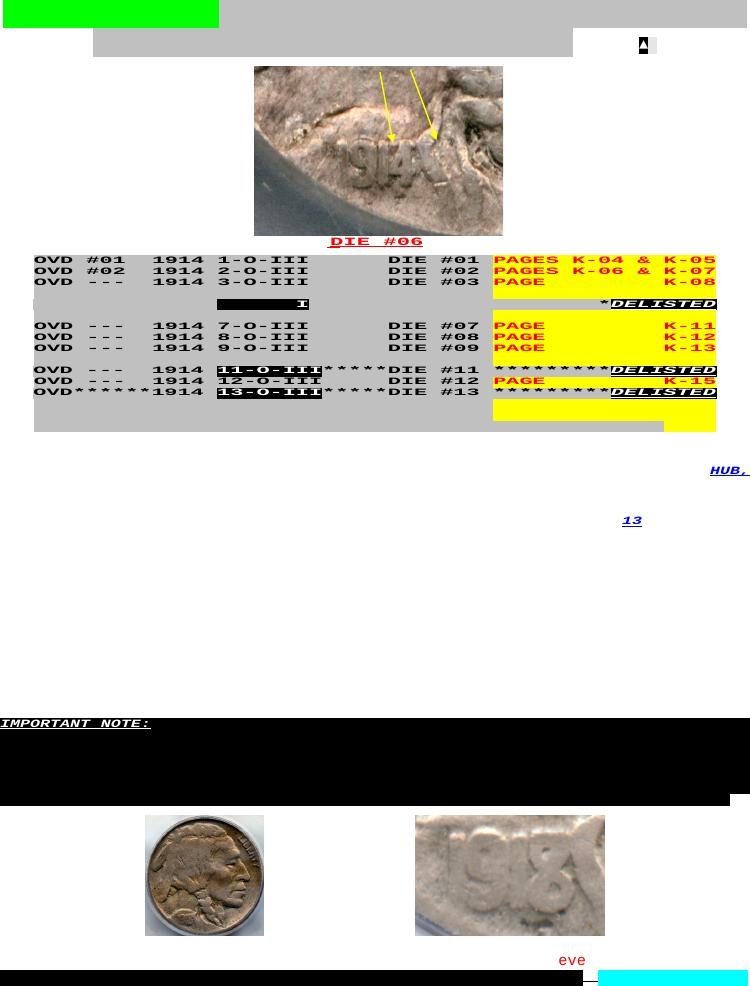
a.k.a "The BUFFINATOR"
I just checked the registry sets and in the basic set with varieties the “1914/3 overdate FS-101” is included and most of the big hitters with these sets have one, some in mint state.
a.k.a "The BUFFINATOR"